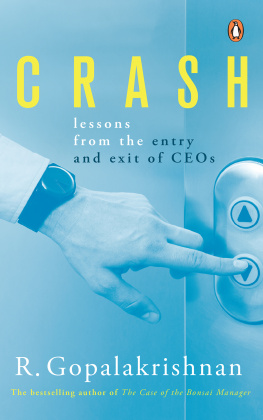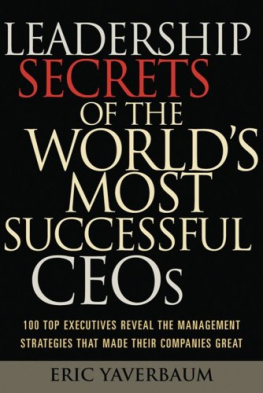The New CEOs
Praise for The New CEOs
This book succeeds at showing the intersection of culture, politics, ethnicity, and feminism through the lens of business diversity studies. An excellent book for scholars interested in data-driven sociology, psychology, and cultural studies relating to business and for readers in the business world.
Library Journal
Glass ceilings and unequal compensation continue to be the norm for American businesses, yet as this informative text highlights, women and people of color are growing in number as leaders of Fortune 500 companies and having a significant impact on the future of business.
Uptown Professional
Filled with sometimes startling statistics, interviews with this new group of leaders make for compelling reading. These CEOs reveal how they came to power, the insights they gained, and how they differ from male CEOs who historically dominated major companies. They also address ongoing issues, including the current debate over CEO compensation. There is little doubt that this influx of new CEOs is bringing major changes to an increasingly globalized world. The New CEOs should be on the must-read list for leaders and potential leaders in all organizations.
Business Lexington
In this new book Richard Zweigenhaft and G. William Domhoff prove they are the best among social and behavioral scientists writing about diversity and inclusion. The findings they present are accessible yet challenging, and the inclusion of appendices, tables, and figures are immensely helpful. It will be essential reading for anyone interested in the new global political economy.
Earl Smith, Rubin Distinguished Professor of American Ethnic Studies and Sociology, Wake Forest University
This book is especially noteworthy because it not only provides the descriptive information about who has reached these positions and what their individual stories entail, but it also asks and endeavors to answer whether having diversity at the highest level of corporations makes a difference and whether we can expect for the trends to continue. All around a useful and important contribution to the literature on inequality and diversity.
Nancy DiTomaso, Vice Dean for Faculty and Research and Professor of Management and Global Business, Rutgers University School of Business
The New CEOs
Women, African American, Latino, and Asian American Leaders of Fortune 500 Companies
Richard L. Zweigenhaft and G. William Domhoff
ROWMAN & LITTLEFIELD
Lanham Boulder New York Toronto Plymouth, UK
Published by Rowman & Littlefield
4501 Forbes Boulevard, Suite 200, Lanham, Maryland 20706
www.rowman.com
10 Thornbury Road, Plymouth PL6 7PP, United Kingdom
Copyright 2011 by Rowman & Littlefield
Introduction to paperback edition copyright 2014 by Rowman & Littlefield
All rights reserved. No part of this book may be reproduced in any form or by any electronic or mechanical means, including information storage and retrieval systems, without written permission from the publisher, except by a reviewer who may quote passages in a review.
British Library Cataloguing in Publication Information Available
The hardback edition of this book was previously cataloged by the Library of Congress as follows:
Zweigenhaft, Richard L.
The new CEOs : women, African American, Latino, and Asian American leaders of Fortune 500 companies / Richard L. Zweigenhaft and G. William Domhoff.
p. cm.
1. Chief executive officers. 2. Women chief executive officers. 3. Minority executives. 4. Women executives. I. Domhoff, G. William. II. Title.
HD38.2.Z94 2010
658.4'2dc22 2011002320
ISBN 978-1-4422-0766-0 (pbk. : alk. paper)
ISBN 978-1-4422-0767-7 (electronic)
 The paper used in this publication meets the minimum requirements of American National Standard for Information SciencesPermanence of Paper for Printed Library Materials, ANSI/NISO Z39.48-1992.
The paper used in this publication meets the minimum requirements of American National Standard for Information SciencesPermanence of Paper for Printed Library Materials, ANSI/NISO Z39.48-1992.
Printed in the United States of America
Preface
I t has been a little over three decades since we began our collaborative efforts on the changes that were taking place in what was once a homogenous white Christian male power structure. We first studied the gradual inclusion of Jews in the corporate elite in the 1960s and 1970s after decades of exclusion, then the successful careers of young low-income African Americans who had been accepted into a then-unique program leading to entrance into high-status preparatory schools and Ivy League colleges, and finally the growing presence of women and people of color in positions of power on corporate boards of directors, in the federal government, and at the top of the military.
In this book, we now take a further step in our attempt to understand diversity by studying the seventy-four women and people of color who have been in what are by all odds the most important positions of power in the United States, outside of the presidency, the chief corporate officers (CEOs) of the large corporations that have dominated the American economy since the beginning of the twentieth century. It is a study that could not have been undertaken fifteen years ago because there were only a few women or people of color running major corporations (and, therefore, the sample size would have been too small for any meaningful patterns to emerge). Although there was increasing corporate diversity in the 1980s and 1990s, it could only be found on boards of directors and in personnel and public relations offices, not in the corner offices on the highest floors of the skyscrapers.
As has been the case for each of our previous books, many people have helped us, and we wish to thank them for their assistance. Three current or recent undergraduates were crucial in helping us to gather data for some of the studies we report on in the text: Kyle Riplinger, a recent graduate of Guilford College, helped conduct the study described in appendix 2 (he is the coauthor of that appendix); Heather Jackson, a recent graduate of the University of North Dakota, did web research for us that allowed us to double-check and to update the information reported in appendix 1; and Isaac Studebaker and Elizabeth Hayton, both Early College students at Guilford College, helped us gather some of the data that went into various studies that we present in chapter 6.
Faculty members at schools around the country have helped us in a variety of ways. Some of them we thank in the text, or in notes, but we wish to thank them here as well in this list of those to whom we are greatly indebted. We thank both Dan Clawson, professor of sociology at the University of Massachusetts, Amherst, and Peter Dreier, professor of political science, Occidental College, for the extremely useful feedback they gave us on early versions of what was to become chapter 5; Roderick Harrison, a sociology professor at Howard University, for guiding us to invaluable data sets, and then going beyond the call to find what we needed in these data sets and sending us summary tables that we used to create the tables on education and income in chapter 6; Rory Kramer, a graduate student in sociology at the University of Pennsylvania, who shared his work on diversifiers with us and guided us to online data about the racial makeup of the Ivy League schools; Robert Livingston, assistant professor of management and organizations at Kellogg School of Management, Northwestern University, and Nicholas Pearce, a doctoral student at the Kellogg School, who generously provided us with the grayscale photographs of CEOs that they used to study babyfaceness in CEOs; Frederick R. Lynch, associate professor of government at Claremont McKenna College, who shared his ideas about the diversity movement with us; Tom Pettigrew, research professor of social psychology at the University of California, Santa Cruz, for helping us to understand the complex nature of the contact between dominant groups and excluded groups and how that contact affects the likelihood of social action; Earl Smith, professor of sociology and the Rubin Distinguished Professor of American Ethnic Studies at Wake Forest University, for an early reading of our prospectus and one chapter, and for the ongoing support he has given us over the years; Cliff Staples, professor of sociology at the University of North Dakota, for generously allowing us to use the extensive information he has gathered on board memberships and memberships in policy groups; and Nancy DiTomaso, professor and chair of the Department of Management and Global Business at Rutgers University, for the useful perspectives she provided to us about the diversity movement and for helping us to see the key role that Roosevelt Thomas played in that movement.
Next page







 The paper used in this publication meets the minimum requirements of American National Standard for Information SciencesPermanence of Paper for Printed Library Materials, ANSI/NISO Z39.48-1992.
The paper used in this publication meets the minimum requirements of American National Standard for Information SciencesPermanence of Paper for Printed Library Materials, ANSI/NISO Z39.48-1992.